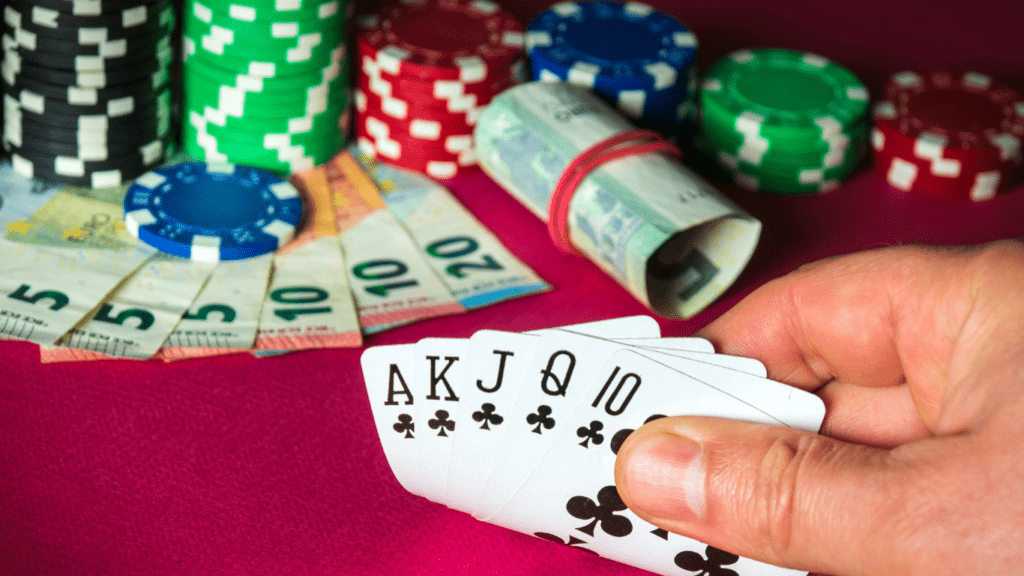The Basics of Poker
Poker combines skill, strategy, and a bit of luck. To excel, one must understand fundamental concepts, including hand rankings and position.
Understanding Hand Rankings
Understanding hand rankings is crucial. Poker hands are ranked from highest to lowest as follows:
- Royal Flush – A, K, Q, J, 10 of the same suit
- Straight Flush – Five consecutive cards of the same suit
- Four of a Kind – Four cards of the same rank
- Full House – Three of a kind plus a pair
- Flush – Five cards of the same suit, not in sequence
- Straight – Five consecutive cards of different suits
- Three of a Kind – Three cards of the same rank
- Two Pair – Two pairs of different ranks
- One Pair – Two cards of the same rank
- High Card – Highest card wins if no other hand is made
The Importance of Position
Position is a key factor in poker strategy. Your position at the table determines the order in which you act.
- Early Position (EP) – First to act, typically under the gun (UTG). Disadvantages include limited information on other players’ actions.
- Middle Position (MP) – Act after EP players, balancing information and action timing.
- Late Position (LP) – Includes the button and cutoff positions. Most advantageous due to maximum information available before acting.
Understanding and leveraging your position can give you significant strategic advantages.
Key Strategies for Success
Mastering poker extends beyond understanding basic rules. Key strategies can significantly improve my chances of success.
Bluffing and Deception
Bluffing involves making opponents believe I have a stronger hand than they do. Effective bluffing requires reading opponents’ tendencies and betting patterns. For example, if a player frequently folds to aggressive bets, they’re prime targets. Balancing my play by mixing bluffs with genuine hands prevents predictability. Semi-bluffing, where I bet with a drawing hand like four cards to a flush, combines deception with the potential for a strong hand if the draw completes.
Bankroll Management

Managing my bankroll ensures I survive long enough to capitalize on good opportunities. This involves setting limits and sticking to them. A general rule is to risk only 1-2% of my total bankroll on a single game. For instance, with a $1,000 bankroll, I’d buy-in for $10-$20 per game. Adjusting bet sizes based on current bankroll helps mitigate potential losses. Tracking wins and losses provides insights into my performance and informs future decision-making.
By implementing these strategies, I can enhance my poker gameplay and increase my chances of success in casinos.
Advanced Techniques
To elevate your poker game and increase your success rate at casinos, mastering advanced techniques is essential. Understanding and implementing these strategies ensure a competitive edge over your opponents.
Reading Opponents
Detecting opponents’ behaviors provides vital information about their cards and strategies. Observing their betting patterns, body language, and reaction times offers clues. For instance, consistent large bets might signal strong hands, while hesitancy may indicate weaker ones. Assessing these factors helps form strategies to counteract their moves and maintain the upper hand.
Pot Odds and Expected Value
Calculating pot odds and expected value can significantly impact decision-making. Pot odds represent the ratio of the current size of the pot to the cost of a contemplated call. For example, if the pot is $80 and a call costs $20, the pot odds are 4:1. Expected value (EV) predicts future profitability of decisions by assessing all possible outcomes. Positive EV indicates a favorable decision over time, while negative EV suggests potential losses. Integrating these calculations allows for more informed and profitable plays.
Common Mistakes to Avoid
Understanding and avoiding common mistakes can significantly increase poker success at casinos.
Playing Too Many Hands
Many players make the mistake of playing too many hands. Not all starting hands hold equal value. For instance, playing a weak hand like 7-2 offsuit can lead to unnecessary losses. I focus on playing strong starting hands, as they generally have higher winning probabilities. According to PokerNews, around 15-20% of hands are worth playing in most games. Waiting for better opportunities improves long-term results and conserves chips for stronger plays.
Ignoring Table Image
Ignoring table image is another frequent error. The way opponents perceive me influences their decisions. For example, if I’m seen as a tight player, my bluffs are more believable. On the other hand, if I often bluff, opponents may call me more often. Adjusting play style based on table image can exploit opponents’ biases to maximize gains. Awareness of my image at the table is essential for strategic decision-making.
Enhancing Your Skills
Improving poker skills means continuous learning and understanding game dynamics. Developing effective strategies and recognizing patterns boosts success in both online and live settings.
Continuous Learning and Adaptation
Studying poker theory, watching professional games, and analyzing hands help refine skills. Poker books, videos, and forums offer valuable insights. Adapting to new trends and strategies keeps your gameplay relevant. I track my progress and adjust based on opponents’ evolving tactics, ensuring constant improvement.
Methods for Continuous Learning
- Poker Books: Titles like “The Theory of Poker” by David Sklansky.
- Online Videos: Platforms like YouTube and Twitch.
- Professional Games Analysis: Reviewing WSOP (World Series of Poker) matches.
Practicing Online vs. Live Games
Online games provide a platform for rapid practice and real-time feedback. Live games offer experience handling physical cues and table dynamics. Balancing both forms hones overall poker competence. I find that online practice sharpens technical skills while live games enhance my ability to read opponents and manage in-person pressures. Combining these practices ensures well-rounded proficiency.
- Speed of Play: Online games move faster than live games.
- Behavioral Cues: Live games require reading physical tells.
- Accessibility: Online games can be accessed anytime, anywhere.
Understanding both environments prepares for any poker scenario, maximizing chances for success at casinos.


 Gary Coxtersons brought his technical expertise to the development of Hype Gamble Match, ensuring the platform’s robust functionality and smooth operation. With a deep understanding of web development and platform integration, Gary was pivotal in building the backend systems that allow for real-time updates and a seamless user experience. His contributions have made it possible for users to access the latest betting odds, insights, and strategies effortlessly, supporting the overall success of the platform.
Gary Coxtersons brought his technical expertise to the development of Hype Gamble Match, ensuring the platform’s robust functionality and smooth operation. With a deep understanding of web development and platform integration, Gary was pivotal in building the backend systems that allow for real-time updates and a seamless user experience. His contributions have made it possible for users to access the latest betting odds, insights, and strategies effortlessly, supporting the overall success of the platform.